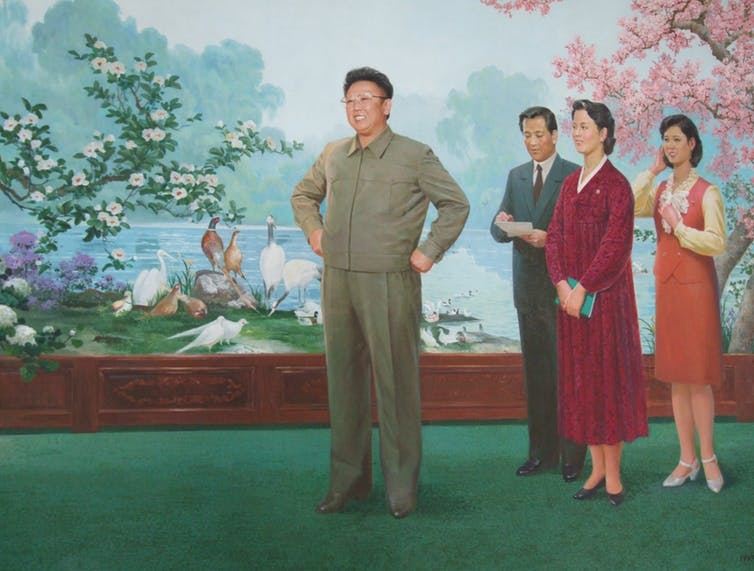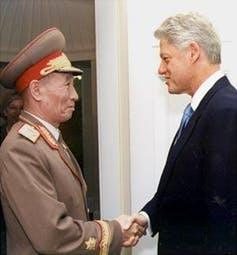Blog | 05 Aug 2017
Why the US’s 1994 deal with North Korea failed – and what Trump can learn from it

It establishes clearly that North Korea delivered its side of the bargain and the US did not. This provides very important background to events on the Korean peninsular.
The article is published below without alteration
Why the US’s 1994 deal with North Korea failed – and what Trump can learn from it

Maria Ryan, University of Nottingham
After more than two decades of testing, North Korea finally has a missile that is powerful enough to deliver a nuclear warhead to US territory – that is, to Alaska and/or Hawaii, if estimates are to be believed. This is an extremely dangerous development, and if the Trump administration is to avoid spiralling into a nuclear confrontation with North Korea, it needs to understand what North Korea wants and why it behaves the way it does.
Fortunately for Trump’s team, there is precedent here. In 1994, the Clinton administration and North Korea signed an Agreed Framework that froze Pyongyang’s nuclear programme and aimed to normalise US-North Korean relations. The agreement targeted many of the issues that the two sides continue to grapple with – but it soon ran into problems, and ultimately broke down in 2002.
Now, the north is closer than ever to a full-blown nuclear missile capability, and that puts the Trump administration under enormous pressure. If the White House wants to get its North Korea policy right, it must try and understand why the US’s last best chance to resolve this crisis ultimately didn’t work out.
Under the terms of the 1994 framework, North Korea agreed to freeze and ultimately dismantle its nuclear programme in exchange for “the full normalisation of political and economic relations with the United States”. This meant four things:
- By 2003, a US-led consortium would build two light-water nuclear reactors in North Korea to compensate for the loss of nuclear power;
- Until then, the US would supply the north with 500,000 tons per year of heavy fuel;
- The US would lift sanctions, remove North Korea from its list of state sponsors of terrorism, and – perhaps most importantly – normalise the political relationship, which is still subject to the terms of the 1953 Korean War armistice;
- Finally, both sides would provide “formal assurances” against the threat or use of nuclear weapons.
For a while, things seemed to be going well. In 1998, US officials involved in the implementation of the agreement testified to Congress that both the US and the International Atomic Energy Agency were satisfied that there had been “no fundamental violation of any aspect of the Framework Agreement” by North Korea.
But on its own pledges, Washington failed to follow through.
Falling short
The light-water reactors were never built. The US-led consortium tasked with constructing them was in severe debt; senators accused Clinton of understating their cost while overstating how much US allies would contribute to funding them. Hawkish Republicans in Congress derided the framework for supposedly rewarding aggressive behaviour.
Heavy fuel shipments were often delayed. Rust Deming, assistant secretary of state, told Congress that “to be frank, we have in past years not always met the fuel year deadline”. Meanwhile, Robert Gallucci, a diplomat who had negotiated the framework, warned that it could fail unless the US did “what it said it would do, which is to take responsibility for the delivery of the heavy fuel oil”.
North Korea was not removed from the State Department’s list of state sponsors of terrorism until 2008, though it had long met the criteria for removal. A limited number of US sanctions were eased, but not until 2000 – six years later than pledged in the Agreed Framework. According to Gallucci, Congressional scepticism about the deal led to “the minimum interpretation of sanctions lifting”. As he told a congressional committee: “the North Koreans have always been disappointed that more has not been done by the US.”

Most importantly, no action was taken to formally end the Korean War – which was never technically ended – by replacing the 1953 ceasefire with a peace treaty. The “formal assurances” that the US would not attack North Korea were not provided until six years after the framework was signed. In the meantime, the Clinton administration unhelpfully persisted in labelling North Korea a “backlash” or “rogue” state, and throughout the 1990s, US military planning was based on the concept of fighting a simultaneous two-front war against Iraq and North Korea.
This only worsened under Washington’s next regime: in 2002, the Bush administration’s Nuclear Posture Review listed North Korea as one country the US might have to use nuclear weapons against, while its 2002 National Security Strategy listed the north as a “rogue” regime against which the US should be prepared to use force. To this day, the US has 28,500 troops stationed across 11 US military bases in South Korea, and the two countries continue with their joint annual military exercises off the coast of the Korean Peninsula.
As abhorrent as the North Korean regime is, it’s not hard to see why the ruling clique might have concluded that Pyongyang remains in Washington’s crosshairs and that the US was never truly committed to the Agreed Framework. Still, as subsequent negotiations have shown, North Korea remains desperate for fuel, and its regime still exhibits a paranoid, self-serving obsession with security. Its past actions strongly suggest that the nuclear programme is a bargaining chip that Pyongyang is prepared to give up under the right circumstances.
The benefits of a new, more robust peace agreement are obvious: an end to the threat of nuclear war in East Asia, and a boost to the global nuclear non-proliferation regime. The story of the 1994 framework proves this is far from impossible, but also that it will demand both careful, determined diplomacy and a commitment to honouring any promises made. Sadly, the Trump administration so far seems capable of neither.
Maria Ryan, Lecturer in American History, University of Nottingham
This article was originally published on The Conversation. Read the original article.

